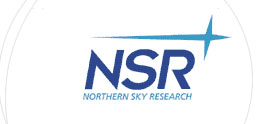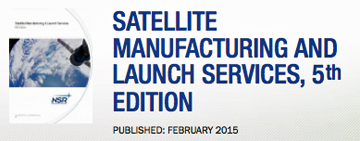[Satnews] By October 1 each year, an average of 18 commercial GEO communications satellites have been procured and 75 percent of annual manufacturing business has been cultivated.
Yet, in 2015, manufacturers have placed a mere 11 satellites under contract, a harvest only 61 percent of that five year average. The industry did not foresee this lower yield. In its Satellite Manufacturing and Launch Services, 5th Edition report, NSR had already forecasted a decline of five satellites compared to 2014 for a total of 23 (an 18 percent drop year over year). However, despite a healthy seeding of RFPs distributed over the past nine months, few satellites have been placed under firm contract, and even this lower order figure now appears unattainable. What has happened?
Specific events, exacerbated by a mounting sense of unease regarding the future shape of the satellite industry, have created a poor growth environment for GEO SATCOM orders. The low market performance in 2015 is a consequence of factors within each segment of a satellite’s lifecycle: manufacturing, launch, and operations:
1. Manufacturing: Export Financing Lower
Over the past 5 years, the importance of export credit agencies (ECAs) in securing manufacturing and launch contracts has grown considerably. For emerging and regional operators, the favorable interest rates and higher risk tolerance offered by ECAs are key to closing a business case, and even established operators able to secure traditional financing are attracted to ECA benefits. But when U.S. Ex-Im authority lapsed in July 2015, funding for satellites from the likes of Orbital ATK, SSL, Boeing, and Lockheed Martin became unavailable. Some have found ways to circumvent this by placing orders through parent companies located in other nations, but for others it has become an impediment to winning business. Exchange rates boosting the U.S. dollar amplify the issue. This is not simply an American detriment that benefits Canadian, European, and Chinese manufacturers since, with less competition in the market as a whole, operators receive fewer and less diverse proposals that limits potential to find the right balance of technology, schedule, and cost. Further, the remaining ECAs are unlikely to have sufficient resources to fully fund all of the considered satellite projects.
2. Launch: Failures on Multiple GTO Vehicles
The GTO market operated at a 6 percent failure rate from 2010-2014—higher than ideal but a tolerable risk. This rose to 12 percent in the first six months of 2015, with failures involving two of the three main GTO vehicles: ILS Proton and SpaceX Falcon 9. These failures delayed the launch schedules of already crowded manifests, pushing into 2016 and likely 2017 the launch of satellites under contract, and increased insurance premiums on future contracts. The resulting insecurity on obtaining a near term successful and timely launch has dampened operator convictions on placing new orders for satellites that might not be launched on time or at all.
3. Operations: Business Plan Insecurity
The amount of players in the GEO SATCOM industry has grown over the last decade, meaning not only more competition but also more diverse approaches to the market. Amid proposals for LEO-HTS constellations, the deployment of more GEO-HTS, and more reconfigurable payloads and on orbit flexibility, operators looking at replacement or expansion satellites have more variables to consider than ever before. In 2015, satellite capacity prices fell across the globe and particularly in prior growth markets Asia and Latin America. Before sending new capacity into a potentially saturated market, operators are pausing to ensure they can achieve reasonable fill rates, ARPUs, and ultimately ROI. Business plans have become more carefully scrutinized. In today’s space industry, heightened risk is not a question—the question is which risk to take. At the outset this involves more careful planning and market considerations with slower, determined action that results in less near term orders.
Bottom Line
Space is a high CAPEX market, making it sensitive to any threat against return on investment. 2015 funding and launch challenges in the face of market uncertainty led to a poor growing season that has left manufacturers with a below average crop of GEO satellite orders. More contracts are expected before the end of the year, including Azerspace-2 and a Telstar 18 replacement, but reaching an anticipated harvest of 23 orders is all but out of reach. NSR already expected lower order levels (17-20 satellites) for 2016-2018, and while 2016 might receive some respite as delayed 2015 orders are realized, the manufacturing market is unlikely to return to the bumper crops of a few years back (30 satellites in 2009).
Analysis and report by Carolyn Belle, Analyst, USA, NSR



